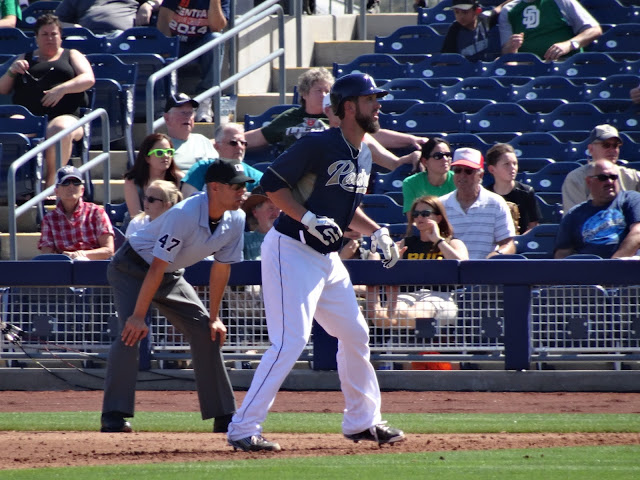 |
| Photo by Daniel Millhouse; pitcher James Shields leading off of first base |
With Major League Baseball coming up on its final year of the current collective bargaining between owners and players, rumors of expanding the role of the designated hitter into the National League have started to spread.
After years of offensive dominance in baseball, the league batting average dropped to .254 which has been the second lowest (the lowest being .251 in 2014) since the inception of the designated hitter position. Some of the owners have been worried about a decline in offensive production hurting attendance numbers.
Contrary to the American League, many of the National League owners of the past were reluctant to even consider adding the position.
Philadelphia Phillies chairman Dave Montgomery told the press, "We would like to remain real baseball." While he's not alone, he's finding those who agree with him to be fewer in numbers.
Newer owners are reconsidering the tradition that has made the NL uniquely different to the AL. With interleague play becoming a daily occurrence now, more AL pitchers are finding themselves hitting than ever before. On the flipside, since NL teams don't normally utilize the position, they focus less on signing nine hitters capable of being in a starting lineup and more on extra pitching. When an NL team plays at an AL park often their DH is just a good bench player compared to the AL teams that have DH's such as David Ortiz and Albert Pujols.
If such an agreement were discussed at the end of this year, the NL teams may find themselves a little behind the AL for the first couple of years. They'd have to compete against the AL to sign DHs from free agency or may have to turn to their minor league system depending on a rookie or younger player in general to provide a boost in offense comparable to the AL DHs.
The rumblings have picked up recently due to several injuries to NL pitchers while hitting. The most significant injury to a pitcher this past season came when the St. Louis Cardinals' Adam Wainwright tore his Achilles while at-bat.
While finding ways to prevent injuries is an admirable thing to do, Major League Baseball has taken it a step further than it should. Many times managers are already too conservative when dealing with their pitchers when it comes to innings pitched and pitches thrown. Once a pitcher hits 75 pitchers, regardless of how well they're pitching, often a reliever can be seen warming up in the bullpen.
Innings leaders in the past before 1980, commonly reached 300 plus innings a season. Now, if a pitcher tossed 230 innings, he is an innings leader and if you're a younger pitcher, you're lucky to hit 150 in a season.
Baseball has become too conservative when it comes to their pitchers. They are not eggs. They will not break.
As far as the lull in offense, just as it has in the past, offensive stats go up then they go down, just like a rollercoaster. Stats were high in the early '60s with legendary hitters like Mantle, Mays, Aaron, Clemente, Robinson, Banks, and many more dominating the game while another good hitter, Roger Maris, broke the record for homers in a season in 1961. By the end of the decade, offensive stats declined, culminating in 1968 when pitchers dominated the game, led by Bob Gibson and his 1.12 ERA, Denny McLain's 31 wins and 1.96 ERA, and Luis Tiant's 1.60 ERA. After the 1968 season, the mound height limit was set at 10 inches, effectively juicing up offensive stats again.
The game has always been a rollercoaster. When offense dominates the game, people debate whether players are taking PED's or if the baseball is "juiced". When the stats drop like where they are today, talks spring up on how to invigorate the slumping offenses. Talking about instilling a DH in the National League is not new. It was discussed in the early '80s once stats started to slump again and now we are back at it again.
Keeping the DH away from the NL is essential. It gives the National League a unique identity compared to its American League counterpart. If the game is homogenized, having two leagues doesn't make as much sense as it once did. If the DH is instilled across baseball, maybe it would be better for Major League Baseball to realign the leagues similar to what the way the NBA has. East and West.
While Joe Torre has denied the discussion has ever come up and Commissioner Rob Manfred has said he has no opinion either way, team owners and chairman have talked about it on the more casual level. With the collective bargaining agreement talks coming up at the end of this year, probability that the DH comes to the National League is a real possibility.
No comments:
Post a Comment